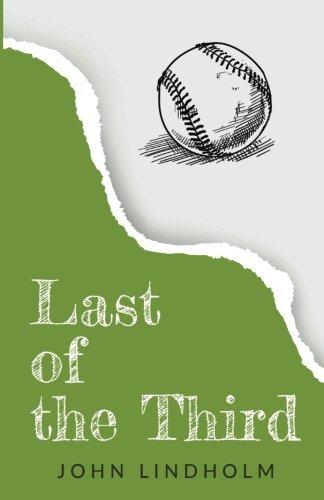This weekend I finished reading Last of the Third by John Lindholm. I hadn’t heard of the book prior to coming across it, but the summary sounded fascinating — and, of course, it’s about baseball — so I figured I’d give it a shot.
The novel’s main character, twenty-two-year-old Shawn McMaster, used to play baseball in his home town of Quail, Pennsylvania as their star left fielder. Shawn was a brilliant fielder, but really just an average hitter, and his performance at the plate caused him no small amount of anxiety. As the story opens, however, the reader quickly realizes that Shawn is in hiding, and we further learn that he hasn’t been home, nor played baseball, in four years. Shawn’s reason for going into hiding remains a mystery for much of the book, as Lindholm reveals that detail of the story inch-by-excruciating-inch over the course of the novel.

One night, Shawn’s whereabouts happen to get discovered by Larry Schneider, better known in Quail as Larry Last, the town oddball and best friend to Shawn’s grandfather, DJ McMaster. Larry relays the details of Shawn’s location to Shawn’s parents, and Shawn’s mother, Greta, convinces her son to return home at last.
Things are awkward, of course. While things in Quail don’t seem to have changed on the surface, Shawn soon realizes that his disappearance has had a profound impact on his parents, his friends, and his girlfriend, CeCe. He continues to struggle with his own self-deprecation, however, and it’s not until his father’s sudden, unexpected death that Shawn finally pulls his head out of his self-loathing and realizes that it’s time to take some responsibility for himself and those he cares about.
Meanwhile, the McMaster property in Quail is in trouble. Larry Last, who was with DJ McMaster in his last moments alive, has a couple of clues on how to save the property, but he is struggling to make sense of them. Lindholm does a fantastic job of dropping enough hints to keep the reader puzzling over the mystery, but not so many as to make it easily solvable. When the solution finally presented itself, I had to tip my hat to the author for his cleverness.
The plot does not follow a linear timeline, but rather jumps back and forth between the novel’s present events and flashing back to those events that brought the characters to where they now stood. I like the general structure of utilizing flashbacks in a story like this, though at times I found myself wishing it didn’t happen quite as often in this book. Most of the chapters are short, and most chapters take place in a different point in time, and so I found myself constantly having to refer back to the dates at the start of each chapter in order to orient myself. I certainly wouldn’t change the structure so much as just combine some of the shorter chapters into longer ones.
I have to confess, there were several instances while reading when I grew quite irritated with both Shawn McMaster and with his girlfriend CeCe. Then it occurred to me, about halfway through the novel, that my irritation with these two characters mirrored my irritation with the college-aged folk whom I deal with on a regular basis. That being said, I came to realize that Lindholm’s character development with regards to these two was actually spot on, and that my frustrations were not due to bad writing, but to really good character portrayal. I’m sure that sounds like a rather convoluted reaction, and it probably is. But it makes sense to my own mind, anyways.
Overall, I enjoyed the book. It is nice, for a change, to have an outfielder be the star of the baseball team, rather than a pitcher or a shortstop or the team’s slugger. It’s definitely a coming-of-age story, though it’s one that happens in an older age group than usually seen in literature. Last of the Third takes the familiarity of baseball, small towns, and pie, and adds a couple of interesting twists to make it unique.

